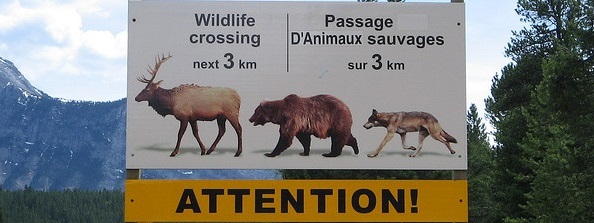
Nadya Hall is a Pace University student, member of Pace Academy’s Environmental Policy Clinic and Academy summer intern. This post also appears at ePolicy, the Clinic’s blog.
Vehicle collisions with wildlife already cost Americans $8 million a year, and accidents are on the rise because more cars and trucks are driving on new roads.
Additionally, at least 200 crashes of the 725,000 to 1.5 million collisions each year will kill the people involved as they hit or swerve to miss the animals. Tens of thousands of others will incur damage to their necks, faces, and heads in the form of abrasions, sprains, and contusions. All of them will experience rising insurance premiums.
The collisions are (for the most part) not due to the animal’s inability to avoid traffic. Instead, their senses are overrun by the basic instinct to find food and water. These resources are often cut off by roadways leaving the animals no choice but to brave the pavement.
Because accidents between animals and people are scattered, happening here, there and everywhere over time, it’s difficult to grasp the scope of roadkill, and understand that it’s a systemic problem. Jeremy Guth, trustee, Woodcock Foundation, and ARC founding sponsor
The sight of road kill has become commonplace and barely receives more than a glance. These deaths are becoming a greater concern as we become more connected, and they, in turn, are torn apart. Road mortality is listed as a major concern for 21 threatened and endangered species of North America. We are carving up habitat for countless wildlife.
In order to avoid the problem, organizations and agencies are building structures that reroute critters over or underneath existing roadways using the principles of transportation ecology. For many smaller animals, underpasses or culverts (built correctly) are enough to give safe passage. Turtles, salamanders, rodents, and even coyote are able to cross along natural paths, avoiding traffic. Larger overpasses are now being built across North America, like this example in Banff, Alberta, to allow for herd and large mammal movement across greater expanses. The ARC (Animal Road Crossing) began holding a contest in the last few years for wildlife crossing designs, like the recent winning design to be built in Colorado.
Wildlife crossings ultimately create safer conditions for humans and wildlife alike. In time these changes will allow all species, including humans, to safely connect to their habitats without unnecessary destruction and mayhem.


